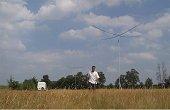Spiderbeam Installationstipps
1. Installation

It can be carried and installed easily by a single person. A small push-up mast and a TV-rotator are totally sufficient, further reducing the weight of the total setup. A very nice feature with such a lightweight antenna setup is the reduced danger. If it ever comes down it is much less likely to cause as much trouble as a heavy aluminum design.
2. Installation height
Especially on HF installation height and an advantageous location
can be much more important than theoretical free space gain.An antenna
with less gain put up high will produce better signals than a lower one
with more gain.
Its low weight makes it much easier to put the
spider beam higher up and choose an advantageous location like a
hilltop, cliff, or a temporary installation on a high rooftop (e.g. for a
contest). In fact, it can be installed in many places where a
conventional tribander would be just too heavy and difficult to install.
As for all HF antennas, the minimum recommended installation height is a half wavelength above ground, or higher.
I suggest mounting the spider beam at least 7-8m (25ft) above ground as a minimum height for DX traffic use.
Again, this depends a lot on the location. On a cliff or hilltop the antenna will work well even on a 4-5m (15ft) pole.
3. Antenna Mast
I have also used a 15m (50ft) aluminum telescopic push up mast (2m transportation length, bottom tube diameter 70mm, top tube diameter 30mm, tube wall thickness 2mm) with very good results. You will notice the extended height especially on 20m. This height (15m) is probably the highest possible for putting the antenna up alone. With 2 or 3 people, it is still very easy.
For fixed installation at home you can save a lot on the tower and rotator as well.
Either also use a push-up mast, or a decent tube mast, ladder mast or wooden pole (flagpole, telephone pole). You can easily build a wooden tower that will carry the spider beam just fine (or even a stack of 2 spider beams).
4. How do I put up the mast and antenna alone?
I get asked this question quite often so I decided to put a little explanation here...
- First, the tripod helps a lot to keep the mast upright as long as the guy lines are not pulled tight.
Anyway, after you have extended the mast to a height of 5m or more the tripod will not help much anymore. - When the mast arrives at that height, pull the guy lines, but not really tight. Leave some slack in the lines.Then push the mast up another 50cm or so, until the guy lines are fully stretched.
- Then walk around and loosen them up a little bit again, so there is again enough slack in the lines to push the mast up another 50cm or so.
- Repeat these steps until the antenna is at full height. That is much faster than you might think..!
- Generally speaking, try to keep the mast as vertical as possible. Otherwhise the telecsopic parts may seize and become difficult to extend
- Take the antenna down the same way, step-by-step.
If there is no wind, I do it another (quicker) way:
First, put up the
mast alone, without antenna at the top and adjust the guy lines to their
proper length. Then take it down again, put antenna on top and put the
mast up again, in one go. Anyway, of course the step-by-step method is
always safer, and is therefore recommended...